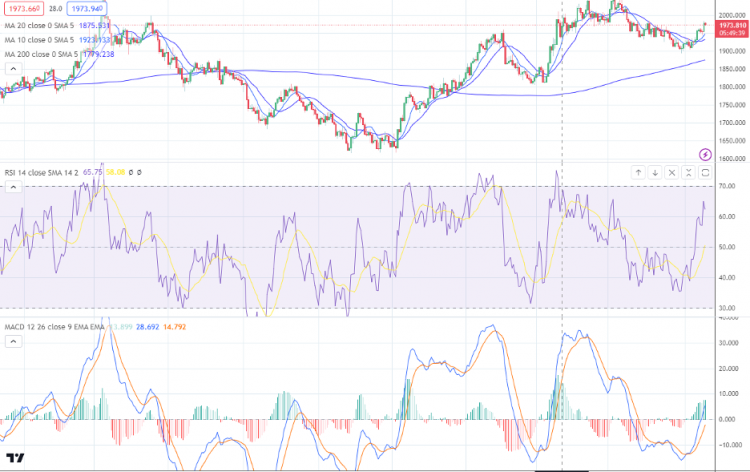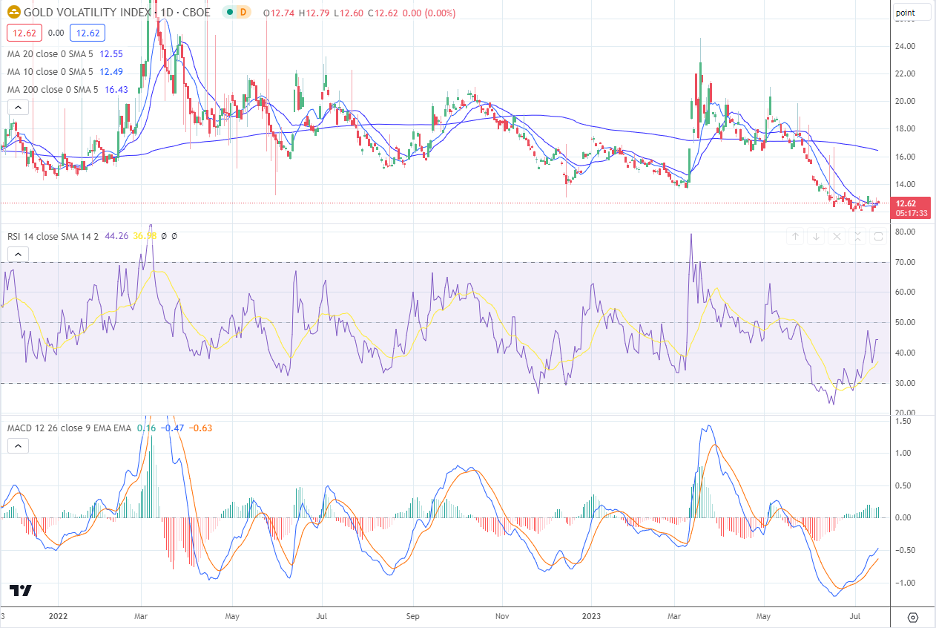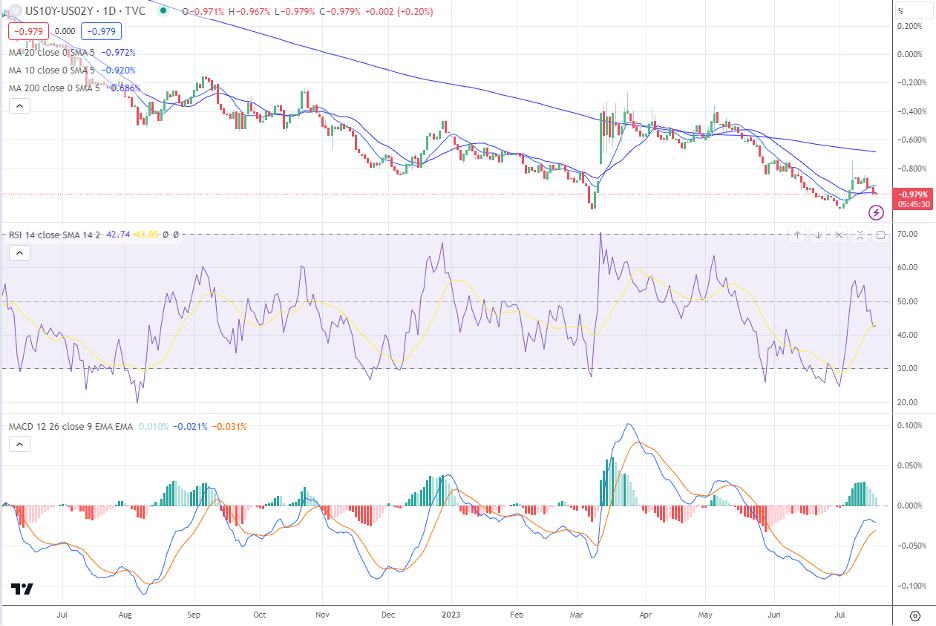Why Gold Volatility Should Cause Concern

Gold prices have been on a wild ride in 2023. We have seen a rally into a selloff and then a repeat of that price action for a second time (see chart). The whipsaw price action has also occurred with a backdrop of aggressive rate increases throughout most of the developed world. Japan and China have been two countries that have sat on the sidelines as Canada’s E.U. U.K., Australia, and The United States have raised rates. Implied volatility (see chart) also saw spikes during 2023, but the recent selloff in gold implied volatility should cause some concern. The selloff shows market participants are complacent about the potential sharp movement in gold prices, similar to other assets. Additionally, interest rates impact the forex markets, and changes in the dollar can impact gold prices. The current yield curve could be a concern to investors that is not incorporated into gold.
Gold Volatility is Depressed
There seems to be little concern amongst investors that there will be large movements in the price of gold. The GVZ is trading near the lowest levels seen on the index in two years. One way to gauge this sentiment is to evaluate the GVZ Index. The CBOE Gold ETF Volatility Index forecasts 30-day volatility of gold prices. A forecast of future volatility is referred to as implied volatility.
Gold implied volatility measures the market’s expectations for future volatility or potential price changes in gold. Based on past price movements, historical volatility is not the same. Implied volatility reflects the market’s anticipation of future events, such as earnings releases, economic data, or other factors impacting gold prices. Traders and investors use implied volatility to assess potential risk and pricing options contracts. Higher implied volatility generally indicates a greater perceived risk or uncertainty in the market. Lower implied volatility typically means complacency. When the GVZ is at low levels, it shows that Gold “at the money” implied volatility is low, and the price of options to hedge is low. When the GVZ is elevated, it shows that option premiums are high and the cost of protection is high.

Implied volatility is an essential concept in options pricing. It refers to the estimated volatility of the underlying asset’s price movement implied by the option’s market price. Recall and option prices the likelihood that the price of an underlying asset like gold will be above the strike price by the expiration date. A model will need a gauge of future volatility to calculate this information.
Options pricing models, such as the Black-Scholes model, use implied volatility to calculate the fair value of an option. When implied volatility is high, it suggests that there is expected to be significant price movement in the underlying asset, making the option more valuable. Conversely, when implied volatility is low, the market anticipates relatively stable price movement, resulting in a lower option value.
Other Markets Show Concern
While there seems to be little concern about a spike in gold prices due to uncertainty, other markets are flashing yellow lights. The two-year yield curve versus the 10-year yield curve is inverted, which usually spells trouble for the U.S. economy.
An inverted yield curve refers to a scenario in the financial markets where short-term interest rates on government bonds yield higher returns than long-term interest rates. In a normal yield curve, longer-term bonds typically offer higher yields as they compensate investors for the added risk of holding the investment for a more extended period.
However, short-term bonds have higher yields during an inversion, indicating the market’s expectation of a potential economic downturn or recession. This phenomenon is often considered a signal of investor pessimism about future economic conditions. Economists and analysts closely monitor the yield curve as it can offer insights into market expectations and have implications for monetary policy and economic outlook.
An inverted yield curve has traditionally been considered a reliable indicator of a future recession. When the yield curve inverts in the United States, short-term interest rates are higher than long-term interest rates. This inversion often occurs when investors anticipate an economic downturn or have concerns about the future. Historically, recessions have usually followed an inverted yield curve, indicating possible economic weakness or uncertainty.
However, it is essential to note that financial markets are complex and can be influenced by various factors, so an inverted yield curve doesn’t guarantee a recession but serves as a warning sign that the economy may be heading toward a downturn.
Higher U.S. Rates Have Weighed on Gold Prices
Higher U.S. interest rates have buoyed the dollar and weighed on gold prices. Higher U.S. interest rates can affect the value of a currency like the dollar. Increasing interest rates can attract more foreign investors seeking higher investment returns. This increased demand for a country’s currency can lead to an appreciation of its value, making it more robust than other currencies, such as the dollar.

Higher interest rates can also make borrowing more expensive, which may slow down economic activity in the short term. This slowdown can reduce the demand for a country’s currency, including the dollar, as it may lead to lower investment and consumption. However, these effects depend on various factors, including the overall economic conditions and investor sentiment.
It’s important to note that interest rates are just one factor influencing the value of a currency. Other factors, such as geopolitical events, economic indicators, and monetary policies, can significantly impact currency valuations.
A stronger dollar typically harms the price of gold. This scenario is because gold is denominated in U.S. dollars, so it takes fewer dollars to buy the same amount when the dollar’s value rises. To compensate for this phenomenon, gold prices will usually decline.
Conversely, when the dollar weakens, more dollars are needed to purchase the same amount of gold, which tends to drive up the demand and price. However, it’s important to note that other factors, such as economic conditions, geopolitical events, and investor sentiment, can also influence the price of gold.
Could Yield Curve Concerns Spill Over Into Gold Prices?
Investors engage in gold trading for a variety of reasons. Gold is often seen as a safe haven or a value store during economic uncertainty. Investors could expect uncertainty with the Fed raising rates from zero to 5.25% over a year and a half.
When currencies fluctuate, investors may seek the stability of gold because it tends to hold its value better than other investments. Gold is also a hedge against inflation since its price can rise due to inflationary pressures. Additionally, some investors buy gold as a diversification strategy to balance their portfolio and reduce overall risk. It’s important to note that individual investment decisions can vary based on personal circumstances and market conditions.
Why Have Interest Rates Risen?
The Federal Reserve may raise interest rates for several reasons. One of their mandates is controlling inflation. The Fed is to maintain stable prices and control inflation. If the economy grows too quickly and inflation becomes a concern, the Fed may raise interest rates to slow down borrowing and consumption, which can help temper inflationary pressures.
By adjusting interest rates, the Fed can influence borrowing costs for businesses and individuals. Raising rates can encourage savings and discourage borrowing, leading to a decrease in spending and investment. This action can help manage overall economic growth and prevent overheating or speculative bubbles.
The decision to raise rates involves careful analysis of multiple economic indicators and is influenced by the objectives set by the central bank. The specific reasons for boosting rates can vary depending on the prevailing economic conditions and policy goals at a given time.
The Bottom Line
Gold prices have been turbulent in 2023 but have been more orderly recently. The whipsaw price action has also occurred with a backdrop of aggressive rate increases. Interest rates impact the forex markets, and changes in the dollar can affect gold prices. Despite higher rates and the uncertainty that lies ahead, gold implied volatility remains depressed. The GVZ Chicago Board of Options Exchange gold implied volatility index is at its lowest in the past few years. These lower levels reflect market complacency, as investors do not seem worried that gold prices will explode due to market disruption. The concern investors might have is that when everything looks rosy, there is usually something that will disrupt the apple cart and drive volatility higher.


























Comments (0 comment(s))